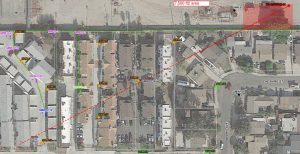Horizontal Wells in the ‘Burbs
Conducting groundwater remediation in a residential area presents a number of unique challenges. The most difficult aspects, as one might expect, revolve around access. In the case of vertical well installations, permanent or at least long-term access must be negotiated in order to connect the well heads. This presents an obvious advantage for horizontal wells; however, even when using HDD there can be issues.
Recently Ellingson DTD personnel completed an ambitious effort to install one biosparge and one soil vapor extraction well beneath a residential neighborhood. DTD crews had already installed several 800+ foot biosparge wells on this site during two previous work phases. The project objective this time around involved extending the treatment area into the groundwater plume extending off site. The contamination source originates underneath a former fuel supply facility in the Southern California area.
Remediation in a Residential Area Usually Means Lots of Utilities
Underground utilities keep our operations managers up at night during almost all of our projects. However they present a particularly difficult challenge when conducting remediation in a residential area. The planned borepaths of these remediation wells crossed a dense utility corridor. Best practices include designing bore profiles in a way that gives underground utilities a wide berth. Unfortunately there are limitations to the extent borepaths can be moved. Due to the unavoidable proximity of the borepath to certain utilities, this project required extensive potholing to meet utility owner requirements. Utilities inspectors maintained a site presence during the drilling, to monitor site activities and provide as-built information to the project foreman as drilling progressed. Initially seasonal rainstorms hampered potholing activities at the site, but the project maintained on track with little delay.
Advanced Navigation Tools Simplify Steering Underneath Residential Neighborhood

Red line depicts general path of two, parallel remediation wells underneath a residential area.
Many HDD navigation systems rely on the “walkover” method of steering. As the name implies, the walkover system requires a technician to physically walk over the planned borepath. Since the borepaths crossed beneath multiple homes, coordinating access for a steering technician threatened to be a logistical nightmare. It was complicated enough getting easements and permission to install the wells underneath people’s homes. Never mind coordinating physical access to their properties above ground!
So, Ellingson-DTD elected to use a gyroscopic steering tool (GST) for navigation. The GST system enables the drilling of the well’s pilot bore without any need for technicians to enter properties above the borepath.
SVE Component Crucial to Sparge/SVE System Underneath Homes
The workplan called for the installation of the SVE well to 20 feet BGS and the biosparge well to 45 feet BGS. The crews completed the biosparge well first. The sparge well consisted of 770 feet of 4-inch PVC installed using the patented Ellingson-DTD Knock Off tool. This method allows single-ended installation of plastic casings for extended lengths in potentially caving soil.
After the sparge well, crews installed the crucial SVE well above. Biosparge wells should provide just enough air to feed the microorganisms that will break down contamination, however it’s a difficult balance. Excess air injected into the formation can mobilize into the soil vapor above the water table. A robust soil vapor extraction system prevents contaminant migration to the surface. In this case, the surface consisted of residential properties, making the SVE component of this remediation system that much more important.
The design called for a 6-inch diameter stainless steel SVE well installed 10 feet from the sparge well. The slotting pattern consisted of several zones of progressively higher open area. This complex well design assured uniform vapor capture along the entire 500 foot length of screen. The total well length tallied to 740 ft. Since they had no adequate exit location in the residential neighborhood, crews also had to complete the SVE well in a “blind” or single-ended configuration.
Pilot Study Refines Design and Boosts Confidence
These two wells extend the treatment zone from previous work at the site. The first 860-foot biosparge well installed at the site, in 2014, proved to have a radius of influence exceeding 100 feet. Technicians even noted elevated dissolved oxygen content in some monitoring wells as far as 200 feet from the sparge well. The results from the pilot testing as well as subsequent wells installed in 2017 refined the design for the two wells just completed. The performance data and past experience boosted the confidence of the entire team to tackle a project as complicated and challenging as this one.
Tags: biosparge, blind horizontal wells, difficult access, groundwater remediation, HDD, HDD navigation tools, horizontal remediation wells, horizontal sparge, horizontal SVE, knock-off system, remediation, remediation in a residential area, SVE, underground utilities, vapor mitigation